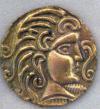Do Stars Fall Quietly into Black Holes, Or Crash into Something Utterly Unknown?

Astronomers in the United States, at the University of Texas at Austin and Harvard University, have put a basic principle of black holes to the test, showing that matter completely vanishes when pulled in. Their results, published in Monthly Notices of the Royal Astronomical Society, constitute another successful test for Albert Einstein’s General Theory of Relativity.
“Our whole point here is to turn this idea of an event horizon into an experimental science, and find out if event horizons really do exist or not,” said Pawan Kumar, a professor of astrophysics at The University of Texas at Austin.
While a singularity has no surface area, the noncollapsed object would have a hard surface. So material being pulled closer — a star, for instance — would not actually fall into a black hole, but hit this hard surface and be destroyed.
Kumar, his graduate student Wenbin Lu, and Ramesh Narayan, a theorist from the Harvard-Smithsonian Center for Astrophysics, have come up with a test to determine which idea is correct.
This is the first in a sequence of two artist’s impressions that shows a huge, massive sphere in the centre of a galaxy, rather than a supermassive black hole. Here a star moves towards and then smashes into the hard surface of the sphere, flinging out debris. The impact heats up the site of the collision.
In this second artist’s impression a huge sphere in the centre of a galaxy is shown after a star has collided with it. Enormous amounts of heat and a dramatic increase in the brightness of the sphere are generated by this event. The lack of observation of such flares from the centre of galaxies means that this hypothetical scenario is almost completely ruled out.
Credit: Mark A. Garlick/CfA
The team figured out what a telescope would see when a star hit the hard surface of a supermassive object at the centre of a nearby galaxy: The star’s gas would envelope the object, shining for months, perhaps even years.
Once they knew what to look for, the team figured out how often this should be seen in the nearby universe, if the hard-surface theory is true.
“We estimated the rate of stars falling onto supermassive black holes,” Lu said. “Nearly every galaxy has one. We only considered the most massive ones, which weigh about 100 million solar masses or more. There are about a million of them within a few billion light-years of Earth.”
“Given the rate of stars falling onto black holes and the number density of black holes in the nearby universe, we calculated how many such transients Pan-STARRS should have detected over a period of operation of 3.5 years. It turns out it should have detected more than 10 of them, if the hard-surface theory is true,” Lu said.
They did not find any.
“Our work implies that some, and perhaps all, black holes have event horizons and that material really does disappear from the observable universe when pulled into these exotic objects, as we’ve expected for decades,” Narayan said. “General Relativity has passed another critical test.”
Now the team is proposing to improve the test with an even larger telescope: the 8.4-meter Large Synoptic Survey Telescope (LSST, now under construction in Chile). Like Pan-STARRS, LSST will make repeated surveys of the sky over time, revealing transients — but with much greater sensitivity.
Contacts and sources:
Rebecca Johnson,UT Austin Astronomy Program
Dr Peter Edmonds, Harvard-Smithsonian Center for Astrophysics
Wenbin Lu, The University of Texas at Austin
Citation: “Stellar disruption events support the existence of the black hole event horizon“, Wenbin Lu, Pawan Kumar and Ramesh Narayan, Monthly Notices of the Royal Astronomical Society, Oxford University Press, vol. 468 (1): pp. 910-919.
Source:
Anyone can join.
Anyone can contribute.
Anyone can become informed about their world.
"United We Stand" Click Here To Create Your Personal Citizen Journalist Account Today, Be Sure To Invite Your Friends.
Please Help Support BeforeitsNews by trying our Natural Health Products below!
Order by Phone at 888-809-8385 or online at https://mitocopper.com M - F 9am to 5pm EST
Order by Phone at 866-388-7003 or online at https://www.herbanomic.com M - F 9am to 5pm EST
Order by Phone at 866-388-7003 or online at https://www.herbanomics.com M - F 9am to 5pm EST
Humic & Fulvic Trace Minerals Complex - Nature's most important supplement! Vivid Dreams again!
HNEX HydroNano EXtracellular Water - Improve immune system health and reduce inflammation.
Ultimate Clinical Potency Curcumin - Natural pain relief, reduce inflammation and so much more.
MitoCopper - Bioavailable Copper destroys pathogens and gives you more energy. (See Blood Video)
Oxy Powder - Natural Colon Cleanser! Cleans out toxic buildup with oxygen!
Nascent Iodine - Promotes detoxification, mental focus and thyroid health.
Smart Meter Cover - Reduces Smart Meter radiation by 96%! (See Video).





